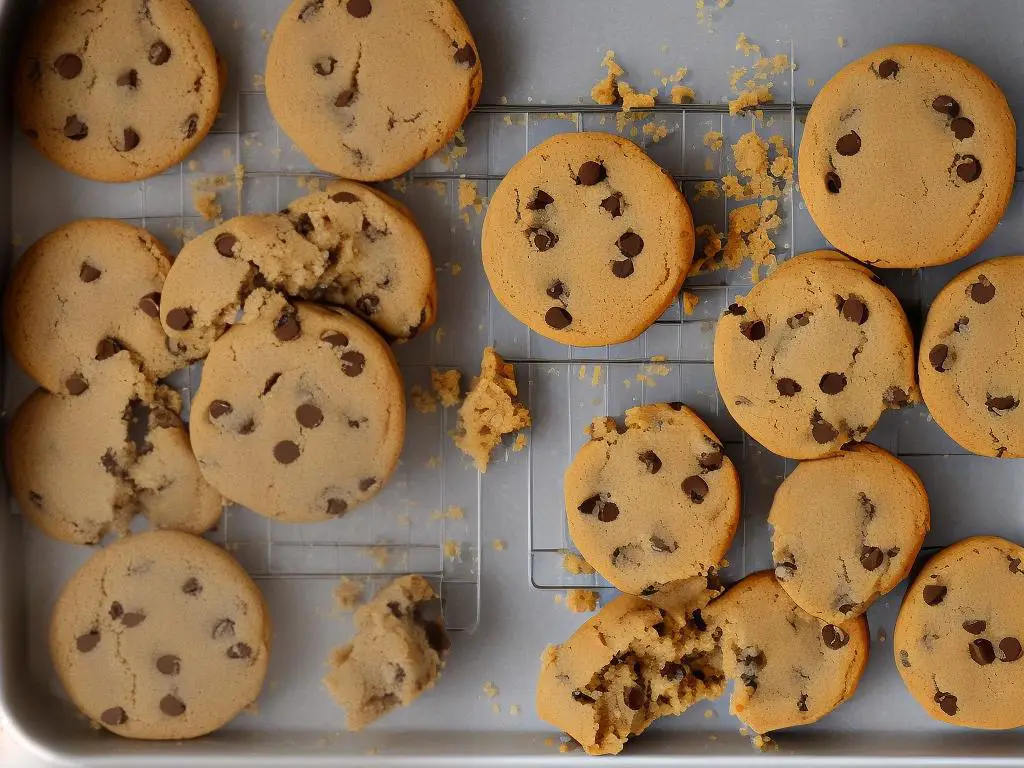How to Freeze Cookie Dough: A Step-by-Step Guide
If you’re a cookie lover, having ready-to-bake homemade cookie dough in your freezer can be a game changer. Having frozen cookie dough on hand not only saves you time, but it also allows you to enjoy freshly baked cookies whenever the craving hits. In this article, we’ll explore how to select the right cookie dough for freezing, preparing the dough, different freezing methods, handling cookie dough in bulk, thawing and baking, and tips to maintain the dough quality.
Selecting the right cookie dough
Selecting the Right Cookie Dough for Freezing
- Choose cookie dough with high fat content: Cookie dough with a higher fat content, such as butter or shortening, tends to freeze better. This includes dough for chocolate chip cookies, sugar cookies, and oatmeal cookies. The fat in the dough helps to keep the cookies moist and maintain their texture when thawed and baked.
- Avoid dough with delicate or airy textures: Certain types of cookie dough, such as those for meringues or macarons, do not freeze well. Their delicate textures may be compromised when thawed, and you may not achieve the desired results when baking them after freezing.
- Be cautious with dough containing add-ins: Cookie dough with added ingredients like fruits, chocolate chips, or nuts can usually be frozen without issue. However, be aware that some ingredients, such as fruits, can become mushy when thawed, which may affect the final texture of your baked cookies.
- Consider freezing slice-and-bake dough: Slice-and-bake cookie dough is ideal for freezing, as it is generally made to be refrigerated or frozen and then sliced and baked as needed. This includes dough for shortbread cookies, pinwheel cookies, and icebox cookies.
How to Freeze Cookie Dough
- Prepare the cookie dough: Follow your preferred cookie dough recipe, mixing and preparing the dough as directed.
- Portion the dough: If you’re making drop cookies or cookies that require rolling, scoop or form the dough into individual balls. Placing them on a parchment-lined baking sheet will help prevent them from sticking during the freezing process.
- Pre-freeze the dough: Place the baking sheet with the individual dough portions in the freezer for about an hour, or until the dough is firm. This step helps prevent the dough from sticking together when transferred to a storage container or freezer bag.
- Package the dough for freezing: Once pre-frozen, transfer the individual dough portions to a freezer-safe container or resealable freezer bag. For slice-and-bake dough, shape the dough into a log and wrap tightly in plastic wrap, then place it in a freezer bag.
- Label and store: Label the container or bag with the date and type of cookie dough for future reference. Store the dough in the freezer for up to 3 months.
- Thawing and baking: When you’re ready to bake your cookies, remove the desired number of dough portions from the freezer and let them thaw in the refrigerator for a few hours or overnight. For slice-and-bake dough, allow it to sit at room temperature for about 10-15 minutes before slicing. Bake according to your recipe’s instructions, adding 1-2 minutes to the baking time if necessary.

Preparing the dough for freezing
Freezing cookie dough is an excellent way to have ready-to-bake cookies on hand whenever you have a craving or need a last-minute dessert. To ensure that your cookies bake perfectly when you’re ready, follow these steps for preparing, portioning, wrapping, and storing the dough for freezing:
- Choose a freezer-friendly dough: Most cookie doughs freeze well, but some doughs, such as those with a delicate texture or high-fat content, may not firm up as well or maintain their shape upon thawing. For the best results, choose a dough that is sturdy, like chocolate chip, oatmeal, or sugar cookie doughs.
- Prepare the dough: Mix the cookie dough according to your recipe’s instructions.
- Portion the dough: Use a cookie scoop, spoon, or your hands to form individual cookie dough balls or portions, about the size recommended in the recipe. If you prefer, you can also roll out and cut the dough into shapes or slice it into rounds.
- Place the dough on a lined baking sheet: Line a baking sheet with wax paper or parchment paper, and arrange the dough portions on the sheet, leaving a small gap between each one to prevent them from sticking together.
- Flash freeze the dough portions: Place the baking sheet in the freezer for about 1-2 hours or until the dough portions are firm. This step helps the dough maintain its shape during the storing process and prevents it from sticking together when you’re ready to bake.
- Wrap the dough: Once the dough portions are firm, remove the baking sheet from the freezer. Wrap each dough portion individually in plastic wrap or aluminium foil, being sure to cover it completely and tightly to protect against freezer burn.
- Label and date the dough: Use a permanent marker to label your wrapped dough portions with the type of cookie and the date. This will help you keep track of how long the dough has been in the freezer and make it easy to identify when you’re ready to bake.
- Store the wrapped dough portions in a freezer-safe container: Transfer the wrapped dough portions into a large resealable plastic freezer bag, a plastic airtight container, or a few smaller containers, depending on your storage space and preferences. Be sure to press out as much air as possible from the storage container to maintain freshness and reduce the risk of freezer burn.
- Freeze the dough for up to 3 months: Place the container of dough portions in the freezer, ensuring it is in a secure place where it won’t be crushed or damaged. Most cookie doughs will keep well in the freezer for up to 3 months. However, it’s best to bake and enjoy your cookies within this time frame for optimal taste and texture.
When you’re ready to bake your cookies, simply remove the desired amount of dough portions from the freezer, unwrap them, and follow your recipe’s baking instructions, allowing a few extra minutes for the cookies to bake properly. With this method, you’ll have delicious, homemade cookies ready in no time, whenever you want them.

Choosing the right freezing method
How to Freeze Cookie Dough: Choosing the Right Freezing Method
Freezing cookie dough is a smart, time-saving technique that allows you to enjoy freshly baked cookies whenever you crave them. By having a stash of cookie dough in your freezer, you can whip up a batch of warm cookies with minimal hands-on time. Below are the different freezing techniques, along with their pros and cons, to help you choose the right freezing method for your needs.
1. Freezing Dough Balls
This method involves portioning the dough into balls before freezing.
Pros:
- Easy to bake: Simply transfer the frozen dough balls to a baking sheet and bake.
- Customizable batch size: Bake as many cookies as you desire, whether it’s just a few or an entire batch.
- Great for drop cookies, such as chocolate chip and oatmeal cookies.
Cons:
- Takes up more freezer space: The dough balls must be initially frozen on a baking sheet to prevent sticking, which can be cumbersome in a crowded freezer.
- Not suitable for all cookie types: Not ideal for cookie types that require rolling and cutting, such as sugar cookies.
Instructions:
- Prepare the cookie dough according to the recipe.
- Use a cookie scoop or tablespoon to scoop the dough into equal-sized balls.
- Line a baking sheet with parchment paper or a silicone baking mat and place the dough balls on it, ensuring they are not touching.
- Place the baking sheet into the freezer for 1-2 hours or until dough balls are firm.
- Transfer the frozen dough balls to an airtight container or a freezer storage bag, label with the cookie type and date, and store in the freezer for up to 3 months.
- To bake, preheat your oven according to the recipe, place the frozen dough balls on a lined baking sheet, and bake for an additional 1-2 minutes compared to the original baking time.
2. Freezing Pre-Portioned Cookies
This method involves rolling, cutting, or shaping the cookies before freezing.
Pros:
- Quick and convenient: The cookies are ready for baking directly from the freezer, requiring minimal preparation.
- Perfect for cut-out cookies, such as sugar or gingerbread cookies.
Cons:
- Less flexible: The entire batch must be defrosted and baked together, limiting the ability to choose a smaller portion size.
- Requires additional preparation: Shaping the cookies in advance takes extra time.
Instructions:
- Prepare the cookie dough according to the recipe.
- Roll out and cut the dough into the desired shapes, or follow the shaping method specified in the recipe.
- Place the shaped cookies on a lined baking sheet with enough space to avoid sticking.
- Put the baking sheet in the freezer for 1-2 hours or until the cookies are firm.
- Transfer the frozen cookies to an airtight container or freezer storage bag, placing wax or parchment paper between layers to prevent sticking. Label with the cookie type and date, and store in the freezer for up to 3 months.
- To bake, preheat your oven according to the recipe, place the frozen cookies on a lined baking sheet, and bake for an additional 1-2 minutes compared to the original baking time.
Recap:
Both methods of freezing cookie dough are effective; however, it is important to consider the type of cookie and your personal preferences when deciding which method to use. Freezing dough balls is ideal for drop cookies and provides greater flexibility in baking smaller portions, while pre-portioned cookies are perfect for cut-out cookies and offer a convenient, ready-to-bake solution.

Freezing cookie dough in bulk
Freezing cookie dough in bulk is a great way to have freshly baked cookies on hand whenever you want them. By properly freezing and storing the dough, you can enjoy delicious cookies without having to mix a new batch every time.Follow these instructions to learn how to freeze large quantities of cookie dough and efficiently use freezer space:1. Prepare your cookie dough: First, prepare your favorite cookie dough recipe as you normally would. If possible, make a double or triple batch to save time and effort on future baking sessions.2. Divide the dough: Before freezing, divide your dough into smaller, more manageable portions that will fit well in your freezer. This not only makes it easier to freeze but also helps the dough thaw more quickly when you’re ready to bake.3. Shape the dough: For most cookie types, shape the dough into individual balls, discs, or logs. This not only makes it easier to freeze and store but also allows you to bake the exact number of cookies you need without thawing the entire batch.4. Place the shaped dough on a baking sheet or plate: Line a baking sheet or large plate with parchment paper or wax paper.5. Freeze the dough initially: Place the baking sheet or plate with the dough pieces into the freezer for about 1-2 hours, or until the dough is firm. This step, called flash freezing, helps keep the cookie dough pieces from sticking together when they’re stored in bulk.6. Transfer the frozen dough to storage bags or containers: Once the dough is firm, remove it from the freezer. Transfer the individual dough pieces to airtight bags or containers. You can use resealable plastic bags or reusable silicone bags, or even plastic wrap if that’s what you prefer. If using bags, squeeze out as much air as possible to prevent freezer burn.7. Label the storage bags or containers: It’s important to label the bags or containers with the cookie dough type, quantity, and the date you prepared the dough. This will help you stay organized and make it easy to find what you’re looking for in your freezer later.8. Stack and store in the freezer: To maximize freezer space, stack the bags or containers in a manner that best fits your freezer. Flat or thin storage containers are great for stacking and take up less space. Make sure the containers are properly sealed to prevent air from entering and causing freezer burn.9. Thaw and bake as needed: When you’re ready to enjoy your cookies, simply remove the desired amount of cookie dough from the freezer, let it thaw at room temperature for about 30 minutes to an hour (depending on the size and type of dough), and then bake according to your recipe’s instructions. You may need to add an extra minute or two of baking time since the dough was frozen.By following these steps, you can easily freeze large batches of cookie dough and enjoy fresh-baked cookies whenever you want. Happy baking!

Thawing and baking frozen cookie dough
How to Freeze Cookie Dough:
- Prepare the cookie dough according to your recipe.
- Using a cookie scoop or a spoon, portion out the dough into individual cookie-sized balls. To make evenly sized cookies, try using a cookie scoop or forming the dough balls with your hands.
- Place the dough balls on a baking sheet lined with parchment paper or a silicone baking mat. Make sure they are spaced apart to prevent them from sticking together.
- Place the baking sheet with the dough balls in the freezer and freeze for at least an hour, or until the dough is firm.
- Once the dough is firm, transfer the dough balls into a freezer-safe container or a resealable plastic bag. Be sure to label the bag with the date and type of cookies to keep track of them easily.
- Store the dough in the freezer for up to three months.
Thawing and Baking Frozen Cookie Dough:
- Preheat your oven according to the cookie recipe’s instructions.
- Remove the frozen cookie dough from the freezer and let it sit at room temperature for about 10-15 minutes to slightly soften. This step is optional but may help the cookies spread more evenly as they bake.
- Line a baking sheet with parchment paper or a silicone baking mat.
- Place the dough balls onto the prepared baking sheet, spacing them about 2 inches apart to allow room for spreading.
- Bake the cookies according to the recipe’s instructions, but be prepared to add a few extra minutes of baking time, as the dough is starting from a frozen state. Keep an eye on the cookies and take them out of the oven when they reach your desired level of doneness.
- Allow the cookies to cool on the baking sheet for a couple of minutes before transferring them to a wire rack to cool completely.
- Enjoy your freshly baked cookies!

Tips for maintaining cookie dough quality
Title: Tips for Maintaining Cookie Dough Quality: Ensuring Tasty and High-Quality Frozen Cookie Dough
Introduction:
Freezing cookie dough is a convenient way to always have fresh-baked cookies on hand, as well as a simple solution for portion control. Yet, to maintain the delectable taste, texture, and quality of your cookies, it’s essential to know how to properly freeze and store cookie dough. In this guide, we will share some valuable tips and tricks to maximize the flavor and integrity of your frozen cookie dough.
1. Choose the right cookie dough:
Not all cookie dough freezes well. Recipes with a good amount of fat, such as butter, work best for freezing, while those with a high liquid content tend to become sticky and difficult to work with. Classic cookie recipes, such as chocolate chip, sugar, and oatmeal, generally freeze well.
2. Freshly prepare the dough:
Freeze cookie dough as soon as it’s made, or at least within 24 hours, to maintain the best flavor and texture. This prevents the dough from becoming dry and crumbly or losing its flavor.
3. Portion cookie dough before freezing:
Before freezing, divide your dough into individual cookie-sized portions using a cookie scoop, a spoon, or your hands. This allows for easy removal of the desired number of cookies without thawing or cutting up an entire batch.
4. Freeze cookie dough individually:
Place the cookie dough portions on a baking sheet lined with parchment paper, making sure they are not touching. Place the sheet in the freezer for about 1 hour or until the dough is firm. This will ensure the cookies don’t stick together when you transfer them to a storage container.
5. Store dough properly:
Transfer the individually frozen cookie dough portions to an airtight container or heavy-duty freezer bag. Make sure to remove as much air as possible before sealing, to prevent freezer burn. Label the container with the type of cookies and the date they were prepared, so you can quickly identify your cookie dough and know when it’s time to discard it.
6. Store for optimal freshness:
Cookie dough can be stored in the freezer for up to 3 months. Beyond this time, the dough may still be safe to eat, but the taste and texture may suffer.
7. Defrosting and baking:
To bake cookies from frozen dough, simply remove the desired number of cookie dough portions from the freezer, place on a lined baking sheet, and let thaw at room temperature for about 10-15 minutes before baking. Some cookies may require a few extra minutes of baking time, so watch them closely and adjust as needed.
Conclusion:
By following these helpful guidelines for freezing cookie dough, you can ensure that you’re always prepared for sudden cookie cravings or unexpected guests. Properly storing and thawing your frozen dough will result in delightful, flavorful cookies that taste like they were made fresh with minimal effort. Enjoy the convenience and reassurance that your cookie dough will maintain its quality and taste in between baking sessions.

Now that you’ve learned how to freeze cookie dough and maximize its quality, you can assure yourself of delicious homemade cookies whenever you want. By selecting the appropriate dough, following proper freezing techniques, and thawing and baking with care, you’ll be equipped to treat yourself and your loved ones to delightfully fresh and flavorful cookies straight out of your freezer. Happy baking!
